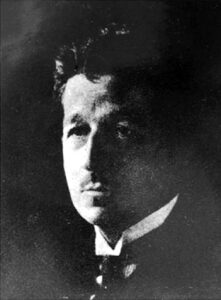
Doctor Edmond Locard was a forensic scientist, popularly regarded as the “Sherlock Holmes of France”. Born in Saint-Chamond on November 13, 1877, Locard studied medicine in Lyon. His interests ultimately branched to include science and medicine in legal matters. He began his professional career by assisting Alexandre Lacassagne, a criminologist and professor. Locard eventually partnered with anthropologist Alphonse Bertillon, who was known for his system of identifying criminals based on their body measurements. During World War I Locard worked with the French Secret Service as a medical examiner. He identified the cause and location of soldiers’ deaths by analyzing their uniforms. In 1910 the Lyon Police Department granted Locard the opportunity to create the first crime investigation laboratory where he could analyze evidence from crime scenes in a previously unused attic space. Over his lifetime, Locard wrote many publications, the most famous being his seven-volume series, Traité de Criminalistique (Treaty of Criminalistics).
Locard is considered a pioneer of forensic science and criminology. He developed multiple methods of forensic analysis that are still in use. He contributed considerable research into dactylography, or the study of fingerprints. Locard believed that if twelve points of comparison could be found between two fingerprints then that would be enough for a positive identification. This was adopted as a preferred means of identification over Bertillon’s method of anthropometry.
Locard’s most famous contribution to forensic science is known today as “Locard’s Exchange Principle”. According to Locard, “it is impossible for a criminal to act, especially considering the intensity of a crime, without leaving traces of this presence”. This means that when an individual commits a crime they leave a trace of themselves at the scene while simultaneously taking something from the scene when they leave. Modern forensic science classifies this phenomenon as trace evidence.
Locard continued to research forensic science techniques until his death on May 4, 1966.
Back to Crime Library
|
|
|
